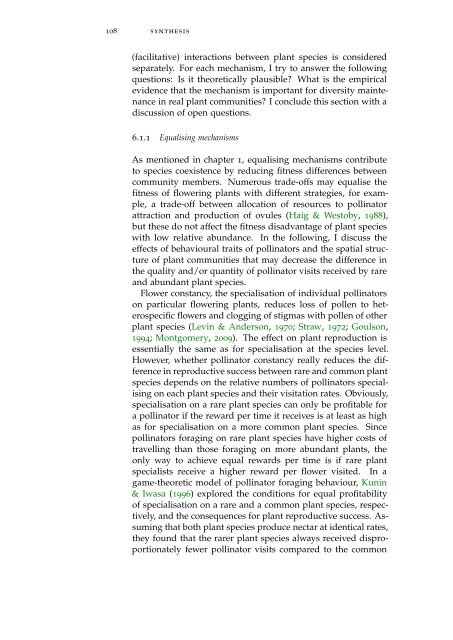Linking Specialisation and Stability of Plant ... - OPUS Würzburg
Linking Specialisation and Stability of Plant ... - OPUS Würzburg
Linking Specialisation and Stability of Plant ... - OPUS Würzburg
You also want an ePaper? Increase the reach of your titles
YUMPU automatically turns print PDFs into web optimized ePapers that Google loves.
108 synthesis<br />
(facilitative) interactions between plant species is considered<br />
separately. For each mechanism, I try to answer the following<br />
questions: Is it theoretically plausible? What is the empirical<br />
evidence that the mechanism is important for diversity maintenance<br />
in real plant communities? I conclude this section with a<br />
discussion <strong>of</strong> open questions.<br />
6.1.1 Equalising mechanisms<br />
As mentioned in chapter 1, equalising mechanisms contribute<br />
to species coexistence by reducing fitness differences between<br />
community members. Numerous trade-<strong>of</strong>fs may equalise the<br />
fitness <strong>of</strong> flowering plants with different strategies, for example,<br />
a trade-<strong>of</strong>f between allocation <strong>of</strong> resources to pollinator<br />
attraction <strong>and</strong> production <strong>of</strong> ovules (Haig & Westoby, 1988),<br />
but these do not affect the fitness disadvantage <strong>of</strong> plant species<br />
with low relative abundance. In the following, I discuss the<br />
effects <strong>of</strong> behavioural traits <strong>of</strong> pollinators <strong>and</strong> the spatial structure<br />
<strong>of</strong> plant communities that may decrease the difference in<br />
the quality <strong>and</strong>/or quantity <strong>of</strong> pollinator visits received by rare<br />
<strong>and</strong> abundant plant species.<br />
Flower constancy, the specialisation <strong>of</strong> individual pollinators<br />
on particular flowering plants, reduces loss <strong>of</strong> pollen to heterospecific<br />
flowers <strong>and</strong> clogging <strong>of</strong> stigmas with pollen <strong>of</strong> other<br />
plant species (Levin & Anderson, 1970; Straw, 1972; Goulson,<br />
1994; Montgomery, 2009). The effect on plant reproduction is<br />
essentially the same as for specialisation at the species level.<br />
However, whether pollinator constancy really reduces the difference<br />
in reproductive success between rare <strong>and</strong> common plant<br />
species depends on the relative numbers <strong>of</strong> pollinators specialising<br />
on each plant species <strong>and</strong> their visitation rates. Obviously,<br />
specialisation on a rare plant species can only be pr<strong>of</strong>itable for<br />
a pollinator if the reward per time it receives is at least as high<br />
as for specialisation on a more common plant species. Since<br />
pollinators foraging on rare plant species have higher costs <strong>of</strong><br />
travelling than those foraging on more abundant plants, the<br />
only way to achieve equal rewards per time is if rare plant<br />
specialists receive a higher reward per flower visited. In a<br />
game-theoretic model <strong>of</strong> pollinator foraging behaviour, Kunin<br />
& Iwasa (1996) explored the conditions for equal pr<strong>of</strong>itability<br />
<strong>of</strong> specialisation on a rare <strong>and</strong> a common plant species, respectively,<br />
<strong>and</strong> the consequences for plant reproductive success. Assuming<br />
that both plant species produce nectar at identical rates,<br />
they found that the rarer plant species always received disproportionately<br />
fewer pollinator visits compared to the common
















